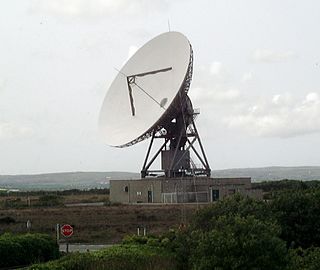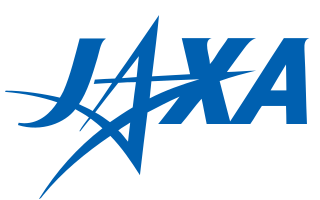
Goonhilly Satellite Earth Station is a large radiocommunication site located on Goonhilly Downs near Helston on the Lizard peninsula in Cornwall, England. Owned by Goonhilly Earth Station Ltd under a 999-year lease from BT Group plc, it was at one time the largest satellite earth station in the world, with more than 30 communication antennas and dishes in use. The site also links into undersea cable lines.

A communications satellite is an artificial satellite that relays and amplifies radio telecommunication signals via a transponder; it creates a communication channel between a source transmitter and a receiver at different locations on Earth. Communications satellites are used for television, telephone, radio, internet, and military applications. Many communications satellites are in geostationary orbit 22,236 miles (35,785 km) above the equator, so that the satellite appears stationary at the same point in the sky; therefore the satellite dish antennas of ground stations can be aimed permanently at that spot and do not have to move to track the satellite. Others form satellite constellations in low Earth orbit, where antennas on the ground have to follow the position of the satellites and switch between satellites frequently.

The NASA Deep Space Network (DSN) is a worldwide network of spacecraft communication ground segment facilities, located in the United States (California), Spain (Madrid), and Australia (Canberra), that supports NASA's interplanetary spacecraft missions. It also performs radio and radar astronomy observations for the exploration of the Solar System and the universe, and supports selected Earth-orbiting missions. DSN is part of the NASA Jet Propulsion Laboratory (JPL).

STS-49 was NASA's maiden flight of the Space Shuttle Endeavour, which launched on May 7, 1992. The primary goal of its nine-day mission was to retrieve an Intelsat VI satellite, Intelsat 603, which failed to leave Low Earth orbit two years before, attach it to a new upper stage, and relaunch it to its intended geosynchronous orbit. After several attempts, the capture was completed with the only three-person extravehicular activity (EVA) in space flight history. It would also stand until STS-102 in 2001 as the longest EVA ever undertaken.

The Goldstone Deep Space Communications Complex (GDSCC), commonly called the Goldstone Observatory, is a satellite ground station located in Fort Irwin in the U.S. state of California. Operated by NASA's Jet Propulsion Laboratory (JPL), its main purpose is to track and communicate with interplanetary space missions. It is named after Goldstone, California, a nearby gold-mining ghost town.

New Norcia Station is an ESTRACK Earth station in Australia for communication with spacecraft after launch, in low Earth orbit, in geostationary orbit and in deep space. It is located 10 kilometres (6.2 mi) south of the town of New Norcia, Western Australia. It was the first ESA deep space ground station, followed by Cebreros Station and Malargüe Station.

The Japan Aerospace Exploration Agency (JAXA) is the Japanese national air and space agency. Through the merger of three previously independent organizations, JAXA was formed on 1 October 2003. JAXA is responsible for research, technology development and launch of satellites into orbit, and is involved in many more advanced missions such as asteroid exploration and possible human exploration of the Moon. Its motto is One JAXA and its corporate slogan is Explore to Realize.

The Italian Space Agency is a government agency established in 1988 to fund, regulate and coordinate space exploration activities in Italy. The agency cooperates with numerous national and international entities who are active in aerospace research and technology.

Project Echo was the first passive communications satellite experiment. Each of the two American spacecraft, launched in 1960 and 1964, were metalized balloon satellites acting as passive reflectors of microwave signals. Communication signals were transmitted from one location on Earth and bounced off the surface of the satellite to another Earth location.

A ground station, Earth station, or Earth terminal is a terrestrial radio station designed for extraplanetary telecommunication with spacecraft, or reception of radio waves from astronomical radio sources. Ground stations may be located either on the surface of the Earth, or in its atmosphere. Earth stations communicate with spacecraft by transmitting and receiving radio waves in the super high frequency (SHF) or extremely high frequency (EHF) bands. When a ground station successfully transmits radio waves to a spacecraft, it establishes a telecommunications link. A principal telecommunications device of the ground station is the parabolic antenna.

The Canberra Deep Space Communication Complex (CDSCC) is a satellite communication station, part of the Deep Space Network of NASA's Jet Propulsion Laboratory (JPL), located at Tidbinbilla in the Australian Capital Territory. Opened in 1965, the complex was used for tracking the Apollo Lunar Module, and along with its two sister stations at Goldstone, California and Madrid, Spain is now used for tracking and communicating with NASA's spacecraft, particularly interplanetary missions. Its DSS-43 antenna is the only antenna on Earth that can send commands to Voyager 2. It is managed in Australia by the Commonwealth Scientific and Industrial Research Organisation (CSIRO) for NASA’s Space Communications and Navigation program (SCaN) at NASA Headquarters in Washington, D.C.

The Overseas Telecommunications Commission (OTC) was established by Australia in August 1946. It inherited facilities and resources from Amalgamated Wireless Australasia (AWA) and Cable & Wireless, and was charged with responsibility for all international telecommunications services into, through and out of Australia. In effect, all overseas telecommunications was nationalized. Australia was adopting a Commonwealth-wide policy that had been adopted at the Commonwealth conference in 1945. The main goal was to end the artificial routing of traffic to cable or wireless depending on private financial profits.

The Honeysuckle Creek Tracking Station was a NASA Earth station in Australia near Canberra. It was instrumental to the Apollo program. The station was opened in 1967 and closed in 1981.

Maspalomas Station is an INTA-operated, ESTRACK radio antenna ground station for communication with spacecraft located at the southern area of Gran Canaria island, on the INTA campus. It is situated on the Montaña Blanca hill and is visible from the coastal resort of Meloneras, close to Maspalomas. It was originally established in the 1960s to support NASA's nascent human spaceflight program.

The Carnarvon Tracking Station was an Earth tracking station in Australia, located 10 kilometres south of Carnarvon, Western Australia. It operated from 1963 until 1975, during which it supported the Gemini, Apollo and Skylab space programs.

The following outline is provided as an overview of and topical guide to space exploration.
The Manned Space Flight Network was a set of tracking stations built to support the American Mercury, Gemini, Apollo, and Skylab space programs.

The National Aeronautics and Space Administration is an independent agency of the US federal government responsible for the United States' civil space program, aeronautics research and space research. Established in 1958, it succeeded the National Advisory Committee for Aeronautics (NACA) to give the US space development effort a distinct civilian orientation, emphasizing peaceful applications in space science. It has since led most of America's space exploration programs, including Project Mercury, Project Gemini, the 1968–1972 Apollo Moon landing missions, the Skylab space station, and the Space Shuttle. Currently, NASA supports the International Space Station (ISS) along with the Commercial Crew Program, and oversees the development of the Orion spacecraft and the Space Launch System for the lunar Artemis program.

Cooby Creek Tracking Station, an Earth station in Australia, was located 22.5 kilometres (14 mi) north of Toowoomba, Queensland. Built near the Cooby Dam, the station was located in a radio quiet zone, where there were no powerlines and other sources of potential interference.

The forerunner of the Deep Space Network was established in January 1958, when JPL, then under contract to the U.S. Army, deployed portable radio tracking stations in Nigeria, Singapore, and California to receive telemetry and plot the orbit of the Army-launched Explorer 1, the first successful U.S. satellite.


















